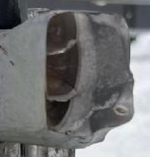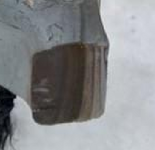dold
Structural
- Aug 19, 2015
- 620
https://unofficialnetworks.com/2025/02/03/details-emerge-attitash-chairlift-detachment/
https://liftblog.com/2025/02/02/chair-falls-from-lift-at-attitash/
More of a maintenance and inspection failure, but interesting photo of the failed part. I'd be interested to hear some of the materials / mech folks' take on that.
Lots of blame going to Vail Resorts (for those not in the know - Vail is the evil megacorp that has bought up tons of small and large resorts across the US and other countries, then hit the "maximize profit" button) for deferred maintenance, lack of training, etc.
Some reports on facebook groups from skiers who were on the lift at the time of failure indicate that the lift faulted at least once and the lift operators kept resetting the faults without much ado.
This failed part is part of the mechanism that attaches / detaches the chair from the rope while going through the terminal, and otherwise holds the chair in place on the rope. Several lift maintenance folks online have said that the wear on the grip that you see is abnormal and indicates misalignment of the grip as it goes through the terminal. The failure surfaces are pretty apparent and pretty corroded. Wild that this was never caught in an inspection.
Interesting discussions on reddit too. Insight from lift operators and lift maintenance/inspection folks.
Failed part (source: reddit). A more zoomed out photo would be nice.
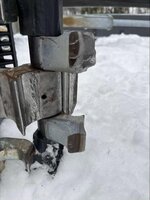
Failed surface shown in red on full part. Not the exact same model of grip but similar. (source: reddit)
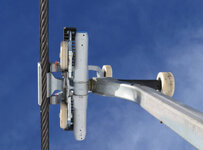
Chair as it lay. Guys is alive (source: liftblog https://liftblog.com/2025/02/02/chair-falls-from-lift-at-attitash/)
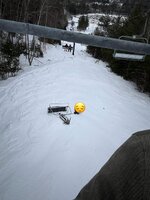
https://liftblog.com/2025/02/02/chair-falls-from-lift-at-attitash/
More of a maintenance and inspection failure, but interesting photo of the failed part. I'd be interested to hear some of the materials / mech folks' take on that.
Lots of blame going to Vail Resorts (for those not in the know - Vail is the evil megacorp that has bought up tons of small and large resorts across the US and other countries, then hit the "maximize profit" button) for deferred maintenance, lack of training, etc.
Some reports on facebook groups from skiers who were on the lift at the time of failure indicate that the lift faulted at least once and the lift operators kept resetting the faults without much ado.
This failed part is part of the mechanism that attaches / detaches the chair from the rope while going through the terminal, and otherwise holds the chair in place on the rope. Several lift maintenance folks online have said that the wear on the grip that you see is abnormal and indicates misalignment of the grip as it goes through the terminal. The failure surfaces are pretty apparent and pretty corroded. Wild that this was never caught in an inspection.
Interesting discussions on reddit too. Insight from lift operators and lift maintenance/inspection folks.
Failed part (source: reddit). A more zoomed out photo would be nice.

Failed surface shown in red on full part. Not the exact same model of grip but similar. (source: reddit)

Chair as it lay. Guys is alive (source: liftblog https://liftblog.com/2025/02/02/chair-falls-from-lift-at-attitash/)


